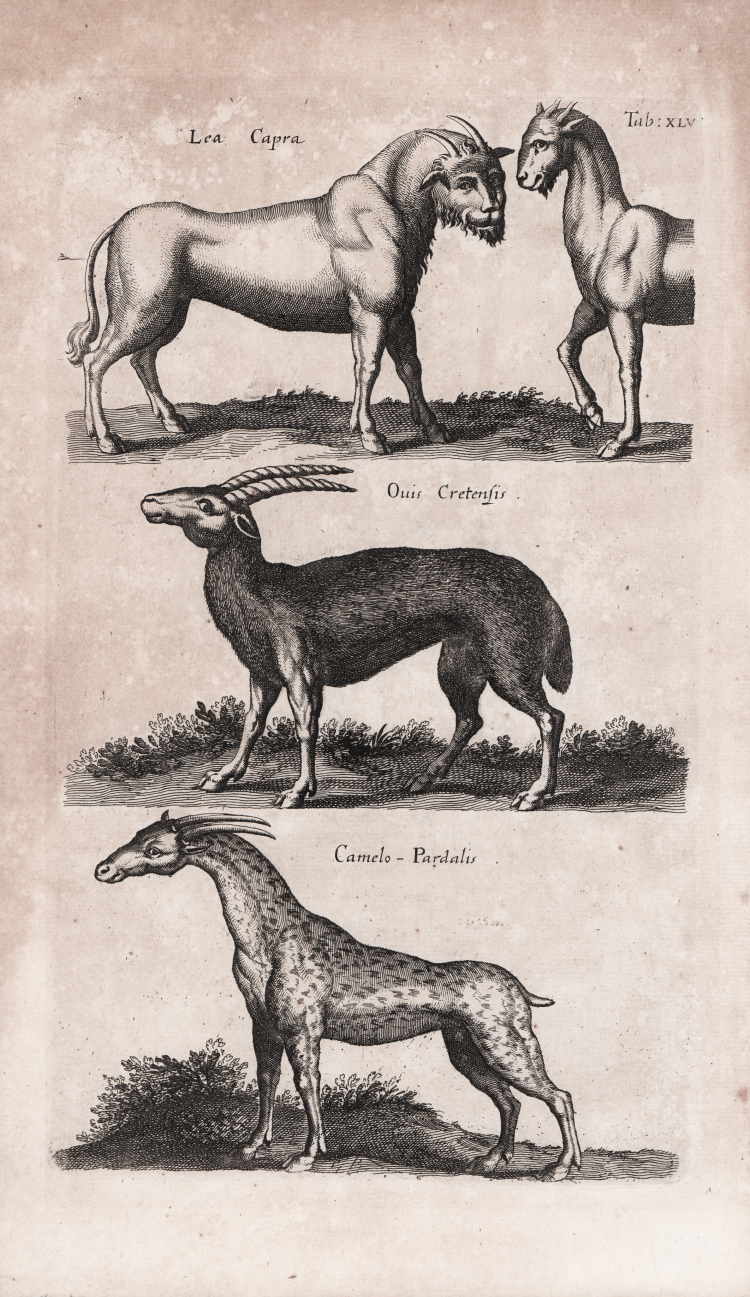



| Reference: | S1355 |
| Author | Matthaus MERIAN "il vecchio" |
| Year: | 1650 ca. |
| Printed: | Frankfurt |
| Measures: | 175 x 295 mm |


| Reference: | S1355 |
| Author | Matthaus MERIAN "il vecchio" |
| Year: | 1650 ca. |
| Printed: | Frankfurt |
| Measures: | 175 x 295 mm |
Copper engraving taken from the Historia Naturalis de quadrupetibus libri … Francoforti ad Moenum impensis Haeredum Math: Meriani; s.d. (United to:) Historiae Naturalis de Auibus libri VI… by Johannes Jonston, with the engraving carved by Matthaeus Merian.
Jonston (1603-1675) was a Polish scientist of Scottish origins. He attended St. Andrews University from 1622, taking more interest in Jewish and Natural Sciences studies, until March 1625. He studied also botany and medicine in Cambridge. In 1634, in Leiden, he became professor in medicine.
Copper engraving, in good condition.
Matthaus MERIAN "il vecchio" (Basilea 1593 - Bad Schwalbach 1650)
|
Known for his mature work as a topographical printmaker based in Germany, Matthaeus Merian spent half a dozen of his early years in Lorraine and Paris (1610-15). He had learned to etch in Basel by 1609, the date on an etching copied from an old view of that city, and had studied etching and glass painting in Zurich in 1610. He was taken to Nancy as the assistant to etcher Friedrich Brentel. In 1610-11 they produced the series of large etchings that documented the funeral of Duke Charles III of Lorraine. In Nancy, Merian came into contact with Jacques Bellange, some of whose etchings he was to copy a few years later. Merian continued on to Paris where he worked productively from 1612-15. He learned by copying works by such French engravers as the portraitists Leonard Gaultier and Thomas de Leu, and the architect Claude Chastillon. He etched portraits of Louis XIII, Marie de Medici, and Anne of Austria, often with views of Paris in the background. He recorded out-of-doors court festivals and royal ceremonies, and public buildings such as the Hotel de Ville. He returned to Basel in 1616, during which time he completed a few plates, for a total of some fifty prints of French subjects.
The artist's total oeuvre is enormous, consisting of nearly 700 single plates and series of prints, plus thousands of additional vignettes, views, and book illustrations. His experience in France was important for him and important for the documentation of French life. Few French-born etchers were active at this time, and Merian's timely and observant images are among the liveliest journalistic records of that era.
In Frankfurt he spent most of his working life and with Martin Zeiller(1589-1661), a German Geographer, and later with his own son, he produced a series of Topographia consisting of 21 volumes including a very large number of town plans as well as maps of most countries and a World Map, a very popular work issued in many editions. He also took over and completed the later parts and editions of the Grand Voyages and Petits Voyages originally started by De Bry in 1590.
|
Matthaus MERIAN "il vecchio" (Basilea 1593 - Bad Schwalbach 1650)
|
Known for his mature work as a topographical printmaker based in Germany, Matthaeus Merian spent half a dozen of his early years in Lorraine and Paris (1610-15). He had learned to etch in Basel by 1609, the date on an etching copied from an old view of that city, and had studied etching and glass painting in Zurich in 1610. He was taken to Nancy as the assistant to etcher Friedrich Brentel. In 1610-11 they produced the series of large etchings that documented the funeral of Duke Charles III of Lorraine. In Nancy, Merian came into contact with Jacques Bellange, some of whose etchings he was to copy a few years later. Merian continued on to Paris where he worked productively from 1612-15. He learned by copying works by such French engravers as the portraitists Leonard Gaultier and Thomas de Leu, and the architect Claude Chastillon. He etched portraits of Louis XIII, Marie de Medici, and Anne of Austria, often with views of Paris in the background. He recorded out-of-doors court festivals and royal ceremonies, and public buildings such as the Hotel de Ville. He returned to Basel in 1616, during which time he completed a few plates, for a total of some fifty prints of French subjects.
The artist's total oeuvre is enormous, consisting of nearly 700 single plates and series of prints, plus thousands of additional vignettes, views, and book illustrations. His experience in France was important for him and important for the documentation of French life. Few French-born etchers were active at this time, and Merian's timely and observant images are among the liveliest journalistic records of that era.
In Frankfurt he spent most of his working life and with Martin Zeiller(1589-1661), a German Geographer, and later with his own son, he produced a series of Topographia consisting of 21 volumes including a very large number of town plans as well as maps of most countries and a World Map, a very popular work issued in many editions. He also took over and completed the later parts and editions of the Grand Voyages and Petits Voyages originally started by De Bry in 1590.
|